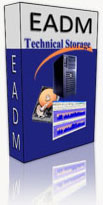Classification of z OS and Open data





Data classification
For several years IT managers have been facing a continuous increase of live and dead files. Consequently some phenomenons become more pronounced: critical applications increase next to consolidations, spread of informational assets, and the emergence of legislation and new standards since 2002.
Back up on disks, disk snapshots, data deduplication, continuous data protection in order to PRA, quick data replication are recent and mature innovations from storage integrator and constructors that help you to protect your data, improve data managing and to resolve challenges linked to storage in your data center. Our tools EADM EATM EADO EATC EAMC estimate and integrate continuously these technological evolutions in order to propose new infrastructures, tested and economical. Our tools are based on ‘Best of Practice ’.
Anticipate: Our services of study often advocate having a global strategy to reach or top the level of service commitment of SLA, all that of course while minimizing costs. They are based on data classification and combine three approaches:
Preventive "How to avoid loss of data in your data center"
We identify two main domains:
- Protection against isolated hardware crash, such as the disks (normally protected in RAID technology), controllers, switches networks, external or internal ports, HBA cards, cartridges, robots etc.
- Protection of the global archiving. We consider archiving as a preventive strategy to protect data. The preservation of data for a long period is a real challenge : identify information that need to be archived, define the duration of data holding back with your architects, the levels of safety and authentication required, classify and index your information so as to locate it easily.
Corrective "I have lost data, how can i get them back?"
We identify two major domains:
- The recuperation of data in your data center. As an answer to the loss of data, the recuperation of data restores lost data with a copy full or sequential, or several clones. The most frequent causes are the accidental suppression of data, the softwares disfunctioning, a major breakdown…
- The taking back after an important disaster. The decision to take back is not easy to take but it is the declination of a disaster plan (PRA). It is typically the mean to react in front of a complete loss of data center, caused by events such as fires, catastrophes, flooding, blackout, terrorism attack, epidemics, etc.
Performance "it seems that the production today is more fluid than last Tuesday"
We identify one main domain:
- How can we know if the data center run at an optimum throughput. The analysis of performance is not an easy task and especially next to the arrival of new hardware and software concepts. Our tools enable to quickly get relevant referentials about the I/O conducts. To sum up our tools give you your I/O's signature, then i twill be compared to others in order to locate the problem.
A major challenge for IT managers: considering these five domains as essential and unique : the one of data protection strategy. Profits are measurable quickly. For example archiving data reduce the volume of data to back up every day. An efficient implementation of protection against breakdowns enables a reliable recovery with local or distant ‘snapshots’.
Conclusion
IT managers should evaluate again steadily the implementation of protection for their assets. They should also check if this protection is aligned with the company’s aims, very often progressive because of new standards in risk management inside their company?
Description of the PS CLASSIFICATION offer
This offer "Classification of data" is based on:
- A conversation with your production and system teams,
- The use of our tool EAXX in our data center in Lyon (logging analyses)
This way of functioning will enable you to minimize the use of your internal resources.
This offer "classification of data" includes:
- A study about the distribution and use of your data,
- A study about the management of your back up,
- The projection study in order to classify your data (« from the disk to the tape»).
The projection study, led independently of all constructors, will enable you:
- To have a precise view of state of the art in the field of storage.
- To define/know precisely rules of storage services ( from disk to tape),
- To reduce and master the cost of your storage
- To invoice again the storage cost to your partners.
At the end of our study, we will give you two documents:
- A balance sheet about the current situation of your storage ( the way the space is used, and where your back up are put)
- A synthesis and document of data classification.
These documents will be presented and commented during a final meeting at your company.
